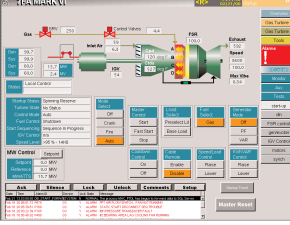
GESPEEDTRONIC™ Mark VI Turbine Control System
sources are provided for each Pyrometer that
returns four 4-20ma inputs. Two Keyphasors are
used for the shaft reference. The VPYR and
matching TPYR support 5,100 rpm shaft speeds
and can be configured to monitor up to 92 buckets with 30 samples per bucket. (See Table 10.)
Operator Interface
The operator interface is commonly referred to
as the Human Machine Interface (HMI). It is a
PC with a Microsoft® Windows NT® operating
system supporting client/server capability, a
CIMPLICITY® graphics display system, a
Control System Toolbox for maintenance, and a
software interface for the Mark VI and other
control systems on the network. (See Figure 3.)
It can be applied as:
■ The primary operator interface for
one or multiple units
■
■ A backup operator interface to the
plant DCS operator interface
■ A gateway for communication links to
other control systems
■ A permanent or temporary
maintenance station
■ An engineer’s workstation
All control and protection is resident in the
Mark VI control, which allows the HMI to be a
non-essential component of the control system.
It can be reinitialized or replaced with the
process running with no impact on the control
system. The HMI communicates with the main
processor card in the Control Module via the
Ethernet based Unit Data Highway (UDH). All
analog and digital data in the Mark VI is accessible for HMI screens including the high resolution time tags for alarms and events.
System (process) alarms and diagnostics alarms
for fault conditions are time tagged at frame
rate (10/20/40 ms) in the Mark VI control and
transmitted to the HMI alarm management system. System events are time tagged at frame
rate, and Sequence of Events (SOE) for contact
inputs are time tagged at 1ms on the contact
input card in the Control Module. Alarms can

be sorted according to ID, Resource, Device,
Time, and Priority. Operators can add comments to alarm messages or link specific alarm
messages to supporting graphics.
Data is displayed in either English or Metric
engineering units with a one-second refresh
rate and a maximum of one second to repaint a
typical display graphic. Operator commands
can be issued by either incrementing / decrementing a setpoint or entering a numerical
value for the new setpoint. Responses to these
commands can be observed on the screen one
second from the time the command was issued.
Security for HMI users is important to restrict
access to certain maintenance functions such as
editors and tuning capability, and to limit certain operations. A system called “User
Accounts” is provided to limit access or use of
particular HMI features. This is done through
the Windows NT User Manager administration
program that supports five user account levels.
Software Maintenance Tools
The Mark VI is a fully programmable control
system. Application software is created from inhouse software automation tools which select
proven GE control and protection algorithms
and integrate them with the I/O, sequencing,
and displays for each application. A library of
software is provided with general-purpose
blocks, math blocks, macros, and application
specific blocks. It uses 32-bit floating point data
(IEEE-854) in a QNX operating system with
real-time applications, multitasking, prioritydriven preemptive scheduling, and fast context
switching.
Software frame rates of 10, 20, and 40 ms are
supported. This is the elapsed time that it takes
to read inputs, condition the inputs, execute
the application software, and send outputs.
Changes to the application software can be
made with password protection (5 levels) and
downloaded to the Control Module while the
process is running. All application software is
stored in the Control Module in non-volatile
flash memory.
Application software is executed sequentially
and represented in its dynamic state in a ladder
diagram format. Maintenance personnel can
add, delete, or change analog loops, sequencing logic, tuning constants, etc. Data points can
be selected and “dragged” on the screen from
one block to another to simplify editing. Other
features include logic forcing, analog forcing,
and trending at frame rate. Application software documentation is created directly from
the source code and printed at the site. This
includes the primary elementary diagram, I/O
assignments, the settings of tuning constants,
etc. The software maintenance tools (Control
System Toolbox) are available in the HMI and
as a separate software package for virtually any
Windows 95 or NT based PC. The same tools
are used for EX2000 Generator Excitation
Systems, and Static Starters. (See Figure 4 and
Figure 5.)
Communications
Communications are provided for internal data
transfer within a single Mark VI control; communications between Mark VI controls and
peer GE control systems; and external communications to remote systems such as a plant distributed control system (DCS).
The Unit Data Highway (UDH) is an Ethernetbased LAN with peer-to-peer communication
between Mark VI controls, EX2000 Generator
Excitation Controls, Static Starters, the GE
Fanuc family of PLC based controls, HMIs, and
Historians. The network uses Ethernet Global
Data (EGD) which is a message-based protocol
with support for sharing information with mul




























































































































